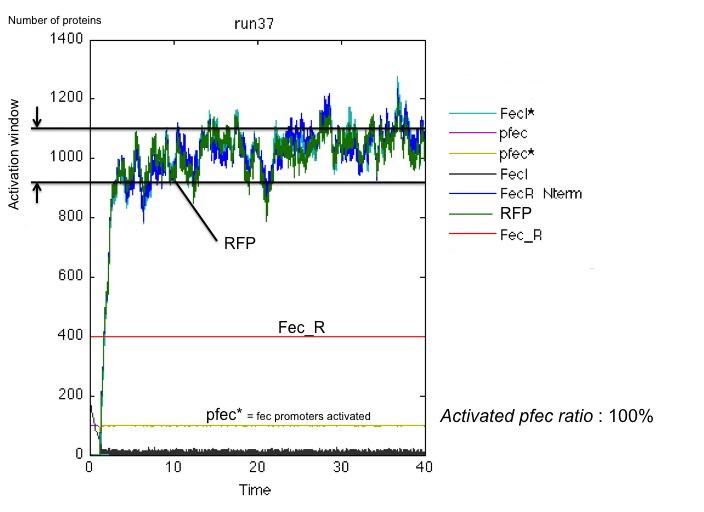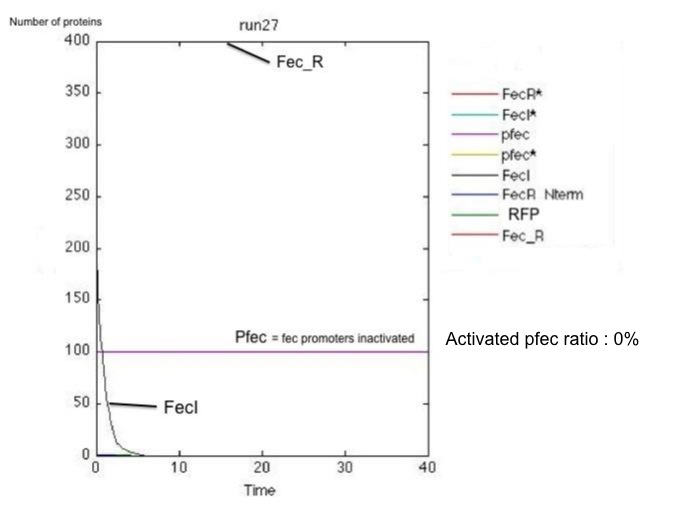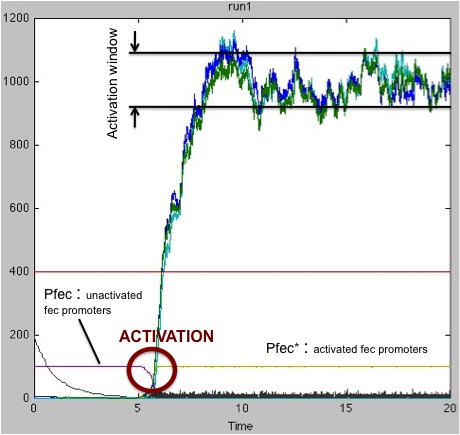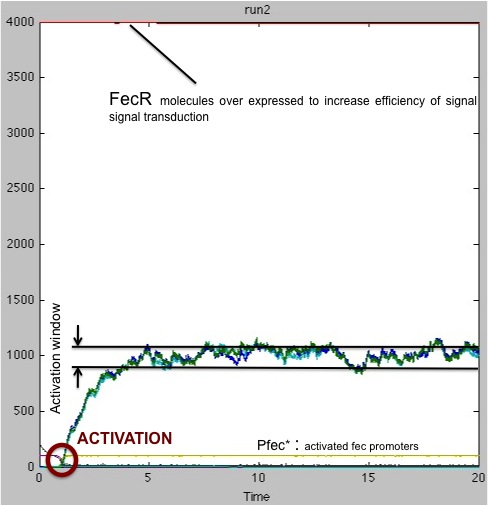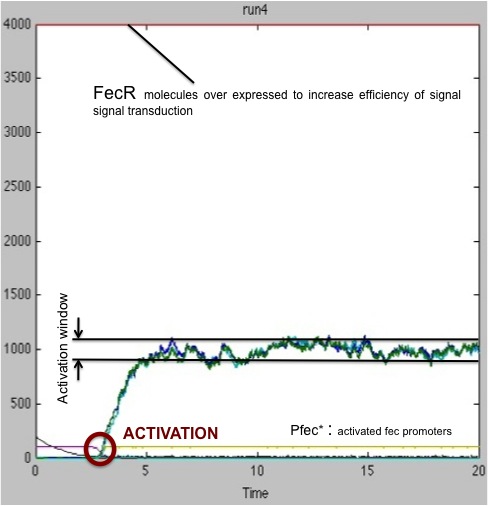Team:Paris/Transduction modeling
From 2009.igem.org
iGEM > Paris > DryLa > Fec operon simulation
Contents |
DryLab - Fec simulation
- Introduction
- The Fec Operon in our system
- Deterministic and Stochastic Simulations
- Results and discussion
Introduction
As explained in the main, the goal of this part is to answer the following question :
Indeed, our reception system uses the fec operon in order to transmit the signal received on the outer membrane via the vesicules into the cytoplasm to induce a response of the reception cells ; to have a reliable communication system, it is crucial to have a robust reception. Due to a little amount of molecules, stochastic simulations were performed to try and solve this problem.
Fec Operon as used in our system
After receiving a little amount of messengers, we wanted to get a good activation of the receiver cells. As a consequence, the transduction cascade used in our system is based on the over expression of constitutively active molecules that induce a positive retro action.
The Chemical Equations
Transduction of signal is initiated by FecA molecules coming from the vesicules ; these molecules reach the bacteria outer membrane where they are in proper conditions to activate the FeR proteins. This "crossing" from OMV to the outer membrane is explicited as a first reaction :
Then, once in the outer membrane, these FecA molecules are able to activate the FecR proteins constitutively present in the receiver. Here we have two possibilities to describe this step :
- the FecA molecule directly activates FecR, and the phnomenon is described in a single reaction :
- or FecA and FecR form a complex which is then destructed to release an activated FecR protein ; this mechanism is described through the 2 following reactions :
As an hypothesis, we considered that the crossing of the periplasm is the limiting step, we decided to examine these two different approaches in our simulations.
The rest of the mecanism is described through a serie of reactions listed below and shown on scheme. To get more details on this description, please see our ????? page.
FecR_Nterm corresponds to the residues ??-??? of FecR which make this molecule constitutively active (the FecR_Nterm is able to activate FecI without needing to be in presence of FecA) ; this is the main conpoment of the positive retro action loop.
Model Hypothesis
For each reaction, we decided to use a mass action law. Each reaction has a kinetic constant k determining the reaction rate given the concentratin of reactants ; the constant names corresponding to each reaction are listed here.
As the number of molecules at stake is very low at the beginning of the reception, we thought that it was more relevant to perform stochastic simulations based on Gillespie algorithm to study the system.
Stochastic Simulations
As explained above, the crossing of the periplasm is considered as the limiting step of the reception. Therefore, we performed various runs of simulations using different values of the kinetics constants caracterising the activation of FecR after crossing the periplasm ; the results of these runs are gathered in the table below showing the quantit of activated cells :
The first results and the examination of the plots of activation highlighted two major problems :
- the reception system is not totally robust : for little amounts of FecA, the activation does not occur in half of the cases.
- the time of activation varies from one cell to the other
To see more simulation plots, please visit this page.
Getting A Robust Reception
To overcome this variability we tried to figure out a way to make the crossing of periplasm easier ; among the solutions that we thought of, the over expression of FecR molecule in receiving cells seemed to be the most appropriate. The presence of a greater number of FecR increases the probability of interaction with FecA molecules coming from vesicules.
We ran another set of simulations, this time only focussing on the case that had given bad results in the previous study ; this time, the quantity of FecR constitutively present in the cells was raised from 400 units to 4000 units.
As seen on these results, the presence of a greater amount of FecR allows a better transduction of signal received ; in 100% of cases, the receiving cell is activated but with a activation time still fluctuating.
Therefore, our advice to the biologist would be to express FecR protein in receiving cells to ensure a robust and reliable reception of signal.
draft
Our reception system uses the fec operon in order to transmit the signal received on the outer membrane via the vesicules into the cytoplasm to induce a response of the reception cells. Once the vesicule has fusioned with the cell, the FecA molecule present on the previous vesicule wall activates the FecR molecule on the inner membrane ; then, the FecI molecule is activated and the pFec promoter is ON and transcription can start.
The plasmid of this reception cell was designed to produce a positive reaction once the signal is received so that, even with a very faint signal (very very few FecA molecules inside the vesicules), the reception population will be activated. To this end, we have placed the of FecR and the FecI coding downstream th epfec promoter. This way, once the first FecR and FecI molecules are produced, they take part in the activation of the pfec promoter thus creating a positive retroaction.
Our modelling study focussed on the description and analysis of this trancriptional cascade in order to caracterize the ability of the system to receive a signal. To this end, we tried to describe the system with elementary chemical equations allowing both deterministic and stochastic simulation runs.
To get more information on this study, please visit the following sections :
- The Fec Operon in our system to read more about the chemical equations chosen to describe the system and the kinetics equations associated
- Deterministic and Stochastic Simulations to read more about the different simulations.
- Results and discussion to learn more about the results of this study.
 "
"


